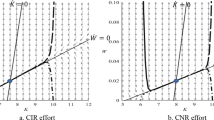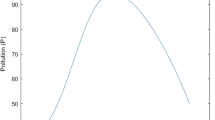Abstract
After having discussed aspects of the resource problem within our capital theoretic approach in the preceding two Chapters, we shall now investigate two interdependencies between environmental protection and the resource problem. These are recycling (the recovery of resources from waste materials) and deposition (the controlled dumping of waste materials in the environmental sector).
Access this chapter
Tax calculation will be finalised at checkout
Purchases are for personal use only
Preview
Unable to display preview. Download preview PDF.
Similar content being viewed by others
Notes
Cf. e.g. Figs. 2.1 and 5.1, Sects. 2.1.1 and 5.1, and the two systems of constraint equations in the appendix to Chap. 2 and in Sect. 5.2.
In the following we shall no longer differentiate between these two versions. The quantity of labor in the resource processes R5 (κ), 0 ≦ κ ≦ 1 will simply be denoted by 15(κ).
This type of regulation of the allocation differs fom that considered by us in our investigation, since we make exclusive use of the price mechanism as an economic regulative mechanism.
To simplify the notation, time indices were omitted in formulae (7.8), (7.9), and (7.10).
Equation (7.11) can be directly derived from from Eq. (6.1). Equation (6.1) is a necessary condition that must be met in order for the production of consumption goods with scarce resources to be engaged in. Since according to assumption 7.3 the structure of the recycling process is identical to that of the extraction process, (7.11) is a direct implication of (6.1). These considerations, however, are only valid if s1 ≦ s2 (cf. Sect. 2.1.3, footnote 8).
This minimum concentration is identical to the minimum concentration of the resource in the environment for the consumption good to be produced with the resource as an input.
Effluents that have to be kept away from the groundwater may, for example, be emitted from the deposit (cf. SIMONS, HANSEL, and Meseck 1981 and Jaeger and Wiener 1981).
This Section is based on Sect. 4 of Faber (1985).
Lind (1982:9) reports that “… Resources for the Future sponsored a conference in 1966 on the appropriate rate of discount for evaluating water projects. The foremost economists and water policy analysists from the country were invited. After most of a day of debate without agreement on the conceptual basis for the choice of the discount rate, one of the conference’s organizers posed the question. If you had to pick a single number, what would be your personal estimate of the appropriate rate? The answers ranged from a low of 2 to 4 percent, based on the real rate of return on long-tern government bonds, to 20 percent, based on the interest rate for short-term consumer credits.”
Spiegel (1971) “makes a contribution to the recent literature by taking note of the subjectivist position of Democritus (Greek philosopher of the fifth century B.C., the authors), among whose fragments survives a suggestion that improved levels of satisfaction can be achieved by reducing personal demand as well as by increasing supply.” (LOWREY 1979:66)
Author information
Authors and Affiliations
Rights and permissions
Copyright information
© 1995 Springer-Verlag Berlin Heidelberg
About this chapter
Cite this chapter
Faber, M., Niemes, H., Stephan, G. (1995). Interdependencies Between Environmental Protection and Resource Use Exemplified for Recycling and Deposition. In: Entropy, Environment and Resources. Springer, Berlin, Heidelberg. https://doi.org/10.1007/978-3-642-57832-8_8
Download citation
DOI: https://doi.org/10.1007/978-3-642-57832-8_8
Publisher Name: Springer, Berlin, Heidelberg
Print ISBN: 978-3-540-58984-6
Online ISBN: 978-3-642-57832-8
eBook Packages: Springer Book Archive




